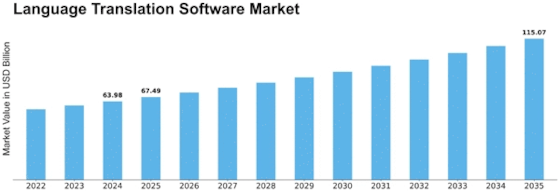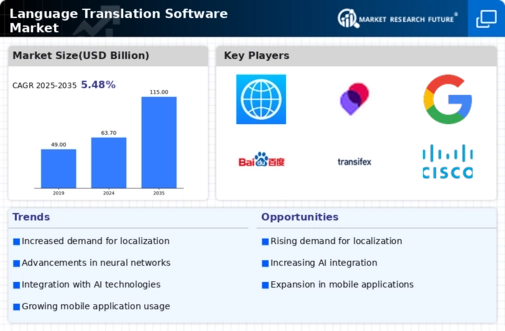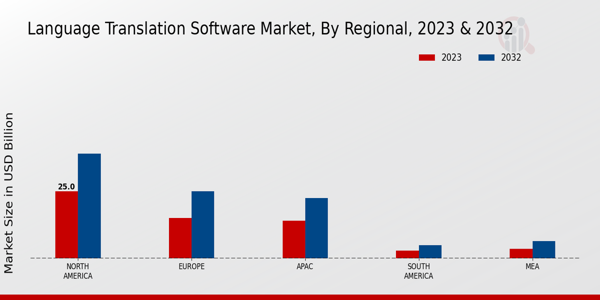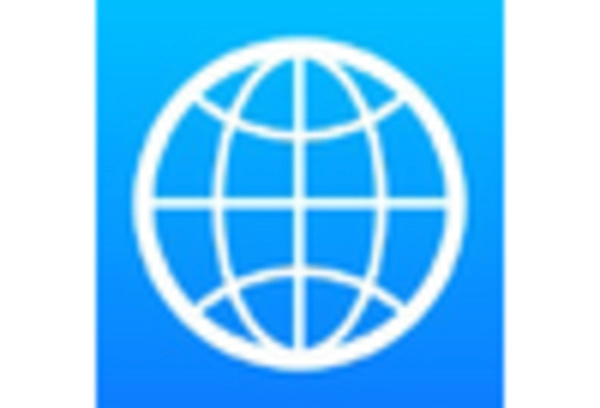-
EXECUTIVE SUMMARY
-
Market Overview
-
Key Findings
-
Market Segmentation
-
Competitive Landscape
-
Challenges and Opportunities
-
Future Outlook
-
MARKET INTRODUCTION
-
Definition
-
Scope of the study
- Research Objective
- Assumption
- Limitations
-
RESEARCH METHODOLOGY
-
Overview
-
Data Mining
-
Secondary Research
-
Primary Research
- Primary Interviews and Information Gathering Process
- Breakdown of Primary Respondents
-
Forecasting Model
-
Market Size Estimation
- Bottom-Up Approach
- Top-Down Approach
-
Data Triangulation
-
Validation
-
MARKET DYNAMICS
-
Overview
-
Drivers
-
Restraints
-
Opportunities
-
MARKET FACTOR ANALYSIS
-
Value chain Analysis
-
Porter''s Five Forces Analysis
- Bargaining Power of Suppliers
- Bargaining Power of Buyers
- Threat of New Entrants
- Threat of Substitutes
- Intensity of Rivalry
-
COVID-19 Impact Analysis
- Market Impact Analysis
- Regional Impact
- Opportunity and Threat Analysis
-
Language Translation Software Market, BY Application (USD Billion)
-
Document Translation
-
Website Translation
-
Mobile App Translation
-
Real-Time Translation
-
Subtitling and Captioning
-
Language Translation Software Market, BY Deployment Type (USD Billion)
-
Cloud-Based
-
On-Premise
-
Hybrid
-
Language Translation Software Market, BY End Use (USD Billion)
-
Education
-
Travel and Tourism
-
E-commerce
-
Healthcare
-
Legal
-
Language Translation Software Market, BY Technology (USD Billion)
-
Machine Translation
-
Human Translation
-
Translation Memory
-
Statistical Translation
-
Neural Machine Translation
-
Language Translation Software Market, BY Regional (USD Billion)
-
North America
- US
- Canada
-
Europe
- Germany
- UK
- France
- Russia
- Italy
- Spain
- Rest of Europe
-
APAC
- China
- India
- Japan
- South Korea
- Malaysia
- Thailand
- Indonesia
- Rest of APAC
-
South America
- Brazil
- Mexico
- Argentina
- Rest of South America
-
MEA
- GCC Countries
- South Africa
- Rest of MEA
-
Competitive Landscape
-
Overview
-
Competitive Analysis
-
Market share Analysis
-
Major Growth Strategy in the Language Translation Software Market
-
Competitive Benchmarking
-
Leading Players in Terms of Number of Developments in the Language Translation Software Market
-
Key developments and growth strategies
- New Product Launch/Service Deployment
- Merger & Acquisitions
- Joint Ventures
-
Major Players Financial Matrix
- Sales and Operating Income
- Major Players R&D Expenditure. 2023
-
Company Profiles
-
iTranslate
- Financial Overview
- Products Offered
- Key Developments
- SWOT Analysis
- Key Strategies
-
Amazon
- Financial Overview
- Products Offered
- Key Developments
- SWOT Analysis
- Key Strategies
-
Memsource
- Financial Overview
- Products Offered
- Key Developments
- SWOT Analysis
- Key Strategies
-
SDL
- Financial Overview
- Products Offered
- Key Developments
- SWOT Analysis
- Key Strategies
-
Google
- Financial Overview
- Products Offered
- Key Developments
- SWOT Analysis
- Key Strategies
-
Baidu
- Financial Overview
- Products Offered
- Key Developments
- SWOT Analysis
- Key Strategies
-
Transifex
- Financial Overview
- Products Offered
- Key Developments
- SWOT Analysis
- Key Strategies
-
Cisco
- Financial Overview
- Products Offered
- Key Developments
- SWOT Analysis
- Key Strategies
-
Crowdin
- Financial Overview
- Products Offered
- Key Developments
- SWOT Analysis
- Key Strategies
-
Phrase
- Financial Overview
- Products Offered
- Key Developments
- SWOT Analysis
- Key Strategies
-
IBM
- Financial Overview
- Products Offered
- Key Developments
- SWOT Analysis
- Key Strategies
-
Microsoft
- Financial Overview
- Products Offered
- Key Developments
- SWOT Analysis
- Key Strategies
-
Smartling
- Financial Overview
- Products Offered
- Key Developments
- SWOT Analysis
- Key Strategies
-
SYSTRAN
- Financial Overview
- Products Offered
- Key Developments
- SWOT Analysis
- Key Strategies
-
Lingmo
- Financial Overview
- Products Offered
- Key Developments
- SWOT Analysis
- Key Strategies
-
Appendix
-
References
-
Related Reports
-
LIST Of tables
-
LIST OF ASSUMPTIONS
-
North America Language Translation Software Market SIZE ESTIMATES & FORECAST, BY APPLICATION, 2019-2032 (USD Billions)
-
North America Language Translation Software Market SIZE ESTIMATES & FORECAST, BY DEPLOYMENT TYPE, 2019-2032 (USD Billions)
-
North America Language Translation Software Market SIZE ESTIMATES & FORECAST, BY END USE, 2019-2032 (USD Billions)
-
North America Language Translation Software Market SIZE ESTIMATES & FORECAST, BY TECHNOLOGY, 2019-2032 (USD Billions)
-
North America Language Translation Software Market SIZE ESTIMATES & FORECAST, BY REGIONAL, 2019-2032 (USD Billions)
-
US Language Translation Software Market SIZE ESTIMATES & FORECAST, BY APPLICATION, 2019-2032 (USD Billions)
-
US Language Translation Software Market SIZE ESTIMATES & FORECAST, BY DEPLOYMENT TYPE, 2019-2032 (USD Billions)
-
US Language Translation Software Market SIZE ESTIMATES & FORECAST, BY END USE, 2019-2032 (USD Billions)
-
US Language Translation Software Market SIZE ESTIMATES & FORECAST, BY TECHNOLOGY, 2019-2032 (USD Billions)
-
US Language Translation Software Market SIZE ESTIMATES & FORECAST, BY REGIONAL, 2019-2032 (USD Billions)
-
Canada Language Translation Software Market SIZE ESTIMATES & FORECAST, BY APPLICATION, 2019-2032 (USD Billions)
-
Canada Language Translation Software Market SIZE ESTIMATES & FORECAST, BY DEPLOYMENT TYPE, 2019-2032 (USD Billions)
-
Canada Language Translation Software Market SIZE ESTIMATES & FORECAST, BY END USE, 2019-2032 (USD Billions)
-
Canada Language Translation Software Market SIZE ESTIMATES & FORECAST, BY TECHNOLOGY, 2019-2032 (USD Billions)
-
Canada Language Translation Software Market SIZE ESTIMATES & FORECAST, BY REGIONAL, 2019-2032 (USD Billions)
-
Europe Language Translation Software Market SIZE ESTIMATES & FORECAST, BY APPLICATION, 2019-2032 (USD Billions)
-
Europe Language Translation Software Market SIZE ESTIMATES & FORECAST, BY DEPLOYMENT TYPE, 2019-2032 (USD Billions)
-
Europe Language Translation Software Market SIZE ESTIMATES & FORECAST, BY END USE, 2019-2032 (USD Billions)
-
Europe Language Translation Software Market SIZE ESTIMATES & FORECAST, BY TECHNOLOGY, 2019-2032 (USD Billions)
-
Europe Language Translation Software Market SIZE ESTIMATES & FORECAST, BY REGIONAL, 2019-2032 (USD Billions)
-
Germany Language Translation Software Market SIZE ESTIMATES & FORECAST, BY APPLICATION, 2019-2032 (USD Billions)
-
Germany Language Translation Software Market SIZE ESTIMATES & FORECAST, BY DEPLOYMENT TYPE, 2019-2032 (USD Billions)
-
Germany Language Translation Software Market SIZE ESTIMATES & FORECAST, BY END USE, 2019-2032 (USD Billions)
-
Germany Language Translation Software Market SIZE ESTIMATES & FORECAST, BY TECHNOLOGY, 2019-2032 (USD Billions)
-
Germany Language Translation Software Market SIZE ESTIMATES & FORECAST, BY REGIONAL, 2019-2032 (USD Billions)
-
UK Language Translation Software Market SIZE ESTIMATES & FORECAST, BY APPLICATION, 2019-2032 (USD Billions)
-
UK Language Translation Software Market SIZE ESTIMATES & FORECAST, BY DEPLOYMENT TYPE, 2019-2032 (USD Billions)
-
UK Language Translation Software Market SIZE ESTIMATES & FORECAST, BY END USE, 2019-2032 (USD Billions)
-
UK Language Translation Software Market SIZE ESTIMATES & FORECAST, BY TECHNOLOGY, 2019-2032 (USD Billions)
-
UK Language Translation Software Market SIZE ESTIMATES & FORECAST, BY REGIONAL, 2019-2032 (USD Billions)
-
France Language Translation Software Market SIZE ESTIMATES & FORECAST, BY APPLICATION, 2019-2032 (USD Billions)
-
France Language Translation Software Market SIZE ESTIMATES & FORECAST, BY DEPLOYMENT TYPE, 2019-2032 (USD Billions)
-
France Language Translation Software Market SIZE ESTIMATES & FORECAST, BY END USE, 2019-2032 (USD Billions)
-
France Language Translation Software Market SIZE ESTIMATES & FORECAST, BY TECHNOLOGY, 2019-2032 (USD Billions)
-
France Language Translation Software Market SIZE ESTIMATES & FORECAST, BY REGIONAL, 2019-2032 (USD Billions)
-
Russia Language Translation Software Market SIZE ESTIMATES & FORECAST, BY APPLICATION, 2019-2032 (USD Billions)
-
Russia Language Translation Software Market SIZE ESTIMATES & FORECAST, BY DEPLOYMENT TYPE, 2019-2032 (USD Billions)
-
Russia Language Translation Software Market SIZE ESTIMATES & FORECAST, BY END USE, 2019-2032 (USD Billions)
-
Russia Language Translation Software Market SIZE ESTIMATES & FORECAST, BY TECHNOLOGY, 2019-2032 (USD Billions)
-
Russia Language Translation Software Market SIZE ESTIMATES & FORECAST, BY REGIONAL, 2019-2032 (USD Billions)
-
Italy Language Translation Software Market SIZE ESTIMATES & FORECAST, BY APPLICATION, 2019-2032 (USD Billions)
-
Italy Language Translation Software Market SIZE ESTIMATES & FORECAST, BY DEPLOYMENT TYPE, 2019-2032 (USD Billions)
-
Italy Language Translation Software Market SIZE ESTIMATES & FORECAST, BY END USE, 2019-2032 (USD Billions)
-
Italy Language Translation Software Market SIZE ESTIMATES & FORECAST, BY TECHNOLOGY, 2019-2032 (USD Billions)
-
Italy Language Translation Software Market SIZE ESTIMATES & FORECAST, BY REGIONAL, 2019-2032 (USD Billions)
-
Spain Language Translation Software Market SIZE ESTIMATES & FORECAST, BY APPLICATION, 2019-2032 (USD Billions)
-
Spain Language Translation Software Market SIZE ESTIMATES & FORECAST, BY DEPLOYMENT TYPE, 2019-2032 (USD Billions)
-
Spain Language Translation Software Market SIZE ESTIMATES & FORECAST, BY END USE, 2019-2032 (USD Billions)
-
Spain Language Translation Software Market SIZE ESTIMATES & FORECAST, BY TECHNOLOGY, 2019-2032 (USD Billions)
-
Spain Language Translation Software Market SIZE ESTIMATES & FORECAST, BY REGIONAL, 2019-2032 (USD Billions)
-
Rest of Europe Language Translation Software Market SIZE ESTIMATES & FORECAST, BY APPLICATION, 2019-2032 (USD Billions)
-
Rest of Europe Language Translation Software Market SIZE ESTIMATES & FORECAST, BY DEPLOYMENT TYPE, 2019-2032 (USD Billions)
-
Rest of Europe Language Translation Software Market SIZE ESTIMATES & FORECAST, BY END USE, 2019-2032 (USD Billions)
-
Rest of Europe Language Translation Software Market SIZE ESTIMATES & FORECAST, BY TECHNOLOGY, 2019-2032 (USD Billions)
-
Rest of Europe Language Translation Software Market SIZE ESTIMATES & FORECAST, BY REGIONAL, 2019-2032 (USD Billions)
-
APAC Language Translation Software Market SIZE ESTIMATES & FORECAST, BY APPLICATION, 2019-2032 (USD Billions)
-
APAC Language Translation Software Market SIZE ESTIMATES & FORECAST, BY DEPLOYMENT TYPE, 2019-2032 (USD Billions)
-
APAC Language Translation Software Market SIZE ESTIMATES & FORECAST, BY END USE, 2019-2032 (USD Billions)
-
APAC Language Translation Software Market SIZE ESTIMATES & FORECAST, BY TECHNOLOGY, 2019-2032 (USD Billions)
-
APAC Language Translation Software Market SIZE ESTIMATES & FORECAST, BY REGIONAL, 2019-2032 (USD Billions)
-
China Language Translation Software Market SIZE ESTIMATES & FORECAST, BY APPLICATION, 2019-2032 (USD Billions)
-
China Language Translation Software Market SIZE ESTIMATES & FORECAST, BY DEPLOYMENT TYPE, 2019-2032 (USD Billions)
-
China Language Translation Software Market SIZE ESTIMATES & FORECAST, BY END USE, 2019-2032 (USD Billions)
-
China Language Translation Software Market SIZE ESTIMATES & FORECAST, BY TECHNOLOGY, 2019-2032 (USD Billions)
-
China Language Translation Software Market SIZE ESTIMATES & FORECAST, BY REGIONAL, 2019-2032 (USD Billions)
-
India Language Translation Software Market SIZE ESTIMATES & FORECAST, BY APPLICATION, 2019-2032 (USD Billions)
-
India Language Translation Software Market SIZE ESTIMATES & FORECAST, BY DEPLOYMENT TYPE, 2019-2032 (USD Billions)
-
India Language Translation Software Market SIZE ESTIMATES & FORECAST, BY END USE, 2019-2032 (USD Billions)
-
India Language Translation Software Market SIZE ESTIMATES & FORECAST, BY TECHNOLOGY, 2019-2032 (USD Billions)
-
India Language Translation Software Market SIZE ESTIMATES & FORECAST, BY REGIONAL, 2019-2032 (USD Billions)
-
Japan Language Translation Software Market SIZE ESTIMATES & FORECAST, BY APPLICATION, 2019-2032 (USD Billions)
-
Japan Language Translation Software Market SIZE ESTIMATES & FORECAST, BY DEPLOYMENT TYPE, 2019-2032 (USD Billions)
-
Japan Language Translation Software Market SIZE ESTIMATES & FORECAST, BY END USE, 2019-2032 (USD Billions)
-
Japan Language Translation Software Market SIZE ESTIMATES & FORECAST, BY TECHNOLOGY, 2019-2032 (USD Billions)
-
Japan Language Translation Software Market SIZE ESTIMATES & FORECAST, BY REGIONAL, 2019-2032 (USD Billions)
-
South Korea Language Translation Software Market SIZE ESTIMATES & FORECAST, BY APPLICATION, 2019-2032 (USD Billions)
-
South Korea Language Translation Software Market SIZE ESTIMATES & FORECAST, BY DEPLOYMENT TYPE, 2019-2032 (USD Billions)
-
South Korea Language Translation Software Market SIZE ESTIMATES & FORECAST, BY END USE, 2019-2032 (USD Billions)
-
South Korea Language Translation Software Market SIZE ESTIMATES & FORECAST, BY TECHNOLOGY, 2019-2032 (USD Billions)
-
South Korea Language Translation Software Market SIZE ESTIMATES & FORECAST, BY REGIONAL, 2019-2032 (USD Billions)
-
Malaysia Language Translation Software Market SIZE ESTIMATES & FORECAST, BY APPLICATION, 2019-2032 (USD Billions)
-
Malaysia Language Translation Software Market SIZE ESTIMATES & FORECAST, BY DEPLOYMENT TYPE, 2019-2032 (USD Billions)
-
Malaysia Language Translation Software Market SIZE ESTIMATES & FORECAST, BY END USE, 2019-2032 (USD Billions)
-
Malaysia Language Translation Software Market SIZE ESTIMATES & FORECAST, BY TECHNOLOGY, 2019-2032 (USD Billions)
-
Malaysia Language Translation Software Market SIZE ESTIMATES & FORECAST, BY REGIONAL, 2019-2032 (USD Billions)
-
Thailand Language Translation Software Market SIZE ESTIMATES & FORECAST, BY APPLICATION, 2019-2032 (USD Billions)
-
Thailand Language Translation Software Market SIZE ESTIMATES & FORECAST, BY DEPLOYMENT TYPE, 2019-2032 (USD Billions)
-
Thailand Language Translation Software Market SIZE ESTIMATES & FORECAST, BY END USE, 2019-2032 (USD Billions)
-
Thailand Language Translation Software Market SIZE ESTIMATES & FORECAST, BY TECHNOLOGY, 2019-2032 (USD Billions)
-
Thailand Language Translation Software Market SIZE ESTIMATES & FORECAST, BY REGIONAL, 2019-2032 (USD Billions)
-
Indonesia Language Translation Software Market SIZE ESTIMATES & FORECAST, BY APPLICATION, 2019-2032 (USD Billions)
-
Indonesia Language Translation Software Market SIZE ESTIMATES & FORECAST, BY DEPLOYMENT TYPE, 2019-2032 (USD Billions)
-
Indonesia Language Translation Software Market SIZE ESTIMATES & FORECAST, BY END USE, 2019-2032 (USD Billions)
-
Indonesia Language Translation Software Market SIZE ESTIMATES & FORECAST, BY TECHNOLOGY, 2019-2032 (USD Billions)
-
Indonesia Language Translation Software Market SIZE ESTIMATES & FORECAST, BY REGIONAL, 2019-2032 (USD Billions)
-
Rest of APAC Language Translation Software Market SIZE ESTIMATES & FORECAST, BY APPLICATION, 2019-2032 (USD Billions)
-
Rest of APAC Language Translation Software Market SIZE ESTIMATES & FORECAST, BY DEPLOYMENT TYPE, 2019-2032 (USD Billions)
-
Rest of APAC Language Translation Software Market SIZE ESTIMATES & FORECAST, BY END USE, 2019-2032 (USD Billions)
-
Rest of APAC Language Translation Software Market SIZE ESTIMATES & FORECAST, BY TECHNOLOGY, 2019-2032 (USD Billions)
-
Rest of APAC Language Translation Software Market SIZE ESTIMATES & FORECAST, BY REGIONAL, 2019-2032 (USD Billions)
-
South America Language Translation Software Market SIZE ESTIMATES & FORECAST, BY APPLICATION, 2019-2032 (USD Billions)
-
South America Language Translation Software Market SIZE ESTIMATES & FORECAST, BY DEPLOYMENT TYPE, 2019-2032 (USD Billions)
-
South America Language Translation Software Market SIZE ESTIMATES & FORECAST, BY END USE, 2019-2032 (USD Billions)
-
South America Language Translation Software Market SIZE ESTIMATES & FORECAST, BY TECHNOLOGY, 2019-2032 (USD Billions)
-
South America Language Translation Software Market SIZE ESTIMATES & FORECAST, BY REGIONAL, 2019-2032 (USD Billions)
-
Brazil Language Translation Software Market SIZE ESTIMATES & FORECAST, BY APPLICATION, 2019-2032 (USD Billions)
-
Brazil Language Translation Software Market SIZE ESTIMATES & FORECAST, BY DEPLOYMENT TYPE, 2019-2032 (USD Billions)
-
Brazil Language Translation Software Market SIZE ESTIMATES & FORECAST, BY END USE, 2019-2032 (USD Billions)
-
Brazil Language Translation Software Market SIZE ESTIMATES & FORECAST, BY TECHNOLOGY, 2019-2032 (USD Billions)
-
Brazil Language Translation Software Market SIZE ESTIMATES & FORECAST, BY REGIONAL, 2019-2032 (USD Billions)
-
Mexico Language Translation Software Market SIZE ESTIMATES & FORECAST, BY APPLICATION, 2019-2032 (USD Billions)
-
Mexico Language Translation Software Market SIZE ESTIMATES & FORECAST, BY DEPLOYMENT TYPE, 2019-2032 (USD Billions)
-
Mexico Language Translation Software Market SIZE ESTIMATES & FORECAST, BY END USE, 2019-2032 (USD Billions)
-
Mexico Language Translation Software Market SIZE ESTIMATES & FORECAST, BY TECHNOLOGY, 2019-2032 (USD Billions)
-
Mexico Language Translation Software Market SIZE ESTIMATES & FORECAST, BY REGIONAL, 2019-2032 (USD Billions)
-
Argentina Language Translation Software Market SIZE ESTIMATES & FORECAST, BY APPLICATION, 2019-2032 (USD Billions)
-
Argentina Language Translation Software Market SIZE ESTIMATES & FORECAST, BY DEPLOYMENT TYPE, 2019-2032 (USD Billions)
-
Argentina Language Translation Software Market SIZE ESTIMATES & FORECAST, BY END USE, 2019-2032 (USD Billions)
-
Argentina Language Translation Software Market SIZE ESTIMATES & FORECAST, BY TECHNOLOGY, 2019-2032 (USD Billions)
-
Argentina Language Translation Software Market SIZE ESTIMATES & FORECAST, BY REGIONAL, 2019-2032 (USD Billions)
-
Rest of South America Language Translation Software Market SIZE ESTIMATES & FORECAST, BY APPLICATION, 2019-2032 (USD Billions)
-
Rest of South America Language Translation Software Market SIZE ESTIMATES & FORECAST, BY DEPLOYMENT TYPE, 2019-2032 (USD Billions)
-
Rest of South America Language Translation Software Market SIZE ESTIMATES & FORECAST, BY END USE, 2019-2032 (USD Billions)
-
Rest of South America Language Translation Software Market SIZE ESTIMATES & FORECAST, BY TECHNOLOGY, 2019-2032 (USD Billions)
-
Rest of South America Language Translation Software Market SIZE ESTIMATES & FORECAST, BY REGIONAL, 2019-2032 (USD Billions)
-
MEA Language Translation Software Market SIZE ESTIMATES & FORECAST, BY APPLICATION, 2019-2032 (USD Billions)
-
MEA Language Translation Software Market SIZE ESTIMATES & FORECAST, BY DEPLOYMENT TYPE, 2019-2032 (USD Billions)
-
MEA Language Translation Software Market SIZE ESTIMATES & FORECAST, BY END USE, 2019-2032 (USD Billions)
-
MEA Language Translation Software Market SIZE ESTIMATES & FORECAST, BY TECHNOLOGY, 2019-2032 (USD Billions)
-
MEA Language Translation Software Market SIZE ESTIMATES & FORECAST, BY REGIONAL, 2019-2032 (USD Billions)
-
GCC Countries Language Translation Software Market SIZE ESTIMATES & FORECAST, BY APPLICATION, 2019-2032 (USD Billions)
-
GCC Countries Language Translation Software Market SIZE ESTIMATES & FORECAST, BY DEPLOYMENT TYPE, 2019-2032 (USD Billions)
-
GCC Countries Language Translation Software Market SIZE ESTIMATES & FORECAST, BY END USE, 2019-2032 (USD Billions)
-
GCC Countries Language Translation Software Market SIZE ESTIMATES & FORECAST, BY TECHNOLOGY, 2019-2032 (USD Billions)
-
GCC Countries Language Translation Software Market SIZE ESTIMATES & FORECAST, BY REGIONAL, 2019-2032 (USD Billions)
-
South Africa Language Translation Software Market SIZE ESTIMATES & FORECAST, BY APPLICATION, 2019-2032 (USD Billions)
-
South Africa Language Translation Software Market SIZE ESTIMATES & FORECAST, BY DEPLOYMENT TYPE, 2019-2032 (USD Billions)
-
South Africa Language Translation Software Market SIZE ESTIMATES & FORECAST, BY END USE, 2019-2032 (USD Billions)
-
South Africa Language Translation Software Market SIZE ESTIMATES & FORECAST, BY TECHNOLOGY, 2019-2032 (USD Billions)
-
South Africa Language Translation Software Market SIZE ESTIMATES & FORECAST, BY REGIONAL, 2019-2032 (USD Billions)
-
Rest of MEA Language Translation Software Market SIZE ESTIMATES & FORECAST, BY APPLICATION, 2019-2032 (USD Billions)
-
Rest of MEA Language Translation Software Market SIZE ESTIMATES & FORECAST, BY DEPLOYMENT TYPE, 2019-2032 (USD Billions)
-
Rest of MEA Language Translation Software Market SIZE ESTIMATES & FORECAST, BY END USE, 2019-2032 (USD Billions)
-
Rest of MEA Language Translation Software Market SIZE ESTIMATES & FORECAST, BY TECHNOLOGY, 2019-2032 (USD Billions)
-
Rest of MEA Language Translation Software Market SIZE ESTIMATES & FORECAST, BY REGIONAL, 2019-2032 (USD Billions)
-
PRODUCT LAUNCH/PRODUCT DEVELOPMENT/APPROVAL
-
ACQUISITION/PARTNERSHIP
-
LIST Of figures
-
MARKET SYNOPSIS
-
NORTH AMERICA LANGUAGE TRANSLATION SOFTWARE MARKET ANALYSIS
-
US LANGUAGE TRANSLATION SOFTWARE MARKET ANALYSIS BY APPLICATION
-
US LANGUAGE TRANSLATION SOFTWARE MARKET ANALYSIS BY DEPLOYMENT TYPE
-
US LANGUAGE TRANSLATION SOFTWARE MARKET ANALYSIS BY END USE
-
US LANGUAGE TRANSLATION SOFTWARE MARKET ANALYSIS BY TECHNOLOGY
-
US LANGUAGE TRANSLATION SOFTWARE MARKET ANALYSIS BY REGIONAL
-
CANADA LANGUAGE TRANSLATION SOFTWARE MARKET ANALYSIS BY APPLICATION
-
CANADA LANGUAGE TRANSLATION SOFTWARE MARKET ANALYSIS BY DEPLOYMENT TYPE
-
CANADA LANGUAGE TRANSLATION SOFTWARE MARKET ANALYSIS BY END USE
-
CANADA LANGUAGE TRANSLATION SOFTWARE MARKET ANALYSIS BY TECHNOLOGY
-
CANADA LANGUAGE TRANSLATION SOFTWARE MARKET ANALYSIS BY REGIONAL
-
EUROPE LANGUAGE TRANSLATION SOFTWARE MARKET ANALYSIS
-
GERMANY LANGUAGE TRANSLATION SOFTWARE MARKET ANALYSIS BY APPLICATION
-
GERMANY LANGUAGE TRANSLATION SOFTWARE MARKET ANALYSIS BY DEPLOYMENT TYPE
-
GERMANY LANGUAGE TRANSLATION SOFTWARE MARKET ANALYSIS BY END USE
-
GERMANY LANGUAGE TRANSLATION SOFTWARE MARKET ANALYSIS BY TECHNOLOGY
-
GERMANY LANGUAGE TRANSLATION SOFTWARE MARKET ANALYSIS BY REGIONAL
-
UK LANGUAGE TRANSLATION SOFTWARE MARKET ANALYSIS BY APPLICATION
-
UK LANGUAGE TRANSLATION SOFTWARE MARKET ANALYSIS BY DEPLOYMENT TYPE
-
UK LANGUAGE TRANSLATION SOFTWARE MARKET ANALYSIS BY END USE
-
UK LANGUAGE TRANSLATION SOFTWARE MARKET ANALYSIS BY TECHNOLOGY
-
UK LANGUAGE TRANSLATION SOFTWARE MARKET ANALYSIS BY REGIONAL
-
FRANCE LANGUAGE TRANSLATION SOFTWARE MARKET ANALYSIS BY APPLICATION
-
FRANCE LANGUAGE TRANSLATION SOFTWARE MARKET ANALYSIS BY DEPLOYMENT TYPE
-
FRANCE LANGUAGE TRANSLATION SOFTWARE MARKET ANALYSIS BY END USE
-
FRANCE LANGUAGE TRANSLATION SOFTWARE MARKET ANALYSIS BY TECHNOLOGY
-
FRANCE LANGUAGE TRANSLATION SOFTWARE MARKET ANALYSIS BY REGIONAL
-
RUSSIA LANGUAGE TRANSLATION SOFTWARE MARKET ANALYSIS BY APPLICATION
-
RUSSIA LANGUAGE TRANSLATION SOFTWARE MARKET ANALYSIS BY DEPLOYMENT TYPE
-
RUSSIA LANGUAGE TRANSLATION SOFTWARE MARKET ANALYSIS BY END USE
-
RUSSIA LANGUAGE TRANSLATION SOFTWARE MARKET ANALYSIS BY TECHNOLOGY
-
RUSSIA LANGUAGE TRANSLATION SOFTWARE MARKET ANALYSIS BY REGIONAL
-
ITALY LANGUAGE TRANSLATION SOFTWARE MARKET ANALYSIS BY APPLICATION
-
ITALY LANGUAGE TRANSLATION SOFTWARE MARKET ANALYSIS BY DEPLOYMENT TYPE
-
ITALY LANGUAGE TRANSLATION SOFTWARE MARKET ANALYSIS BY END USE
-
ITALY LANGUAGE TRANSLATION SOFTWARE MARKET ANALYSIS BY TECHNOLOGY
-
ITALY LANGUAGE TRANSLATION SOFTWARE MARKET ANALYSIS BY REGIONAL
-
SPAIN LANGUAGE TRANSLATION SOFTWARE MARKET ANALYSIS BY APPLICATION
-
SPAIN LANGUAGE TRANSLATION SOFTWARE MARKET ANALYSIS BY DEPLOYMENT TYPE
-
SPAIN LANGUAGE TRANSLATION SOFTWARE MARKET ANALYSIS BY END USE
-
SPAIN LANGUAGE TRANSLATION SOFTWARE MARKET ANALYSIS BY TECHNOLOGY
-
SPAIN LANGUAGE TRANSLATION SOFTWARE MARKET ANALYSIS BY REGIONAL
-
REST OF EUROPE LANGUAGE TRANSLATION SOFTWARE MARKET ANALYSIS BY APPLICATION
-
REST OF EUROPE LANGUAGE TRANSLATION SOFTWARE MARKET ANALYSIS BY DEPLOYMENT TYPE
-
REST OF EUROPE LANGUAGE TRANSLATION SOFTWARE MARKET ANALYSIS BY END USE
-
REST OF EUROPE LANGUAGE TRANSLATION SOFTWARE MARKET ANALYSIS BY TECHNOLOGY
-
REST OF EUROPE LANGUAGE TRANSLATION SOFTWARE MARKET ANALYSIS BY REGIONAL
-
APAC LANGUAGE TRANSLATION SOFTWARE MARKET ANALYSIS
-
CHINA LANGUAGE TRANSLATION SOFTWARE MARKET ANALYSIS BY APPLICATION
-
CHINA LANGUAGE TRANSLATION SOFTWARE MARKET ANALYSIS BY DEPLOYMENT TYPE
-
CHINA LANGUAGE TRANSLATION SOFTWARE MARKET ANALYSIS BY END USE
-
CHINA LANGUAGE TRANSLATION SOFTWARE MARKET ANALYSIS BY TECHNOLOGY
-
CHINA LANGUAGE TRANSLATION SOFTWARE MARKET ANALYSIS BY REGIONAL
-
INDIA LANGUAGE TRANSLATION SOFTWARE MARKET ANALYSIS BY APPLICATION
-
INDIA LANGUAGE TRANSLATION SOFTWARE MARKET ANALYSIS BY DEPLOYMENT TYPE
-
INDIA LANGUAGE TRANSLATION SOFTWARE MARKET ANALYSIS BY END USE
-
INDIA LANGUAGE TRANSLATION SOFTWARE MARKET ANALYSIS BY TECHNOLOGY
-
INDIA LANGUAGE TRANSLATION SOFTWARE MARKET ANALYSIS BY REGIONAL
-
JAPAN LANGUAGE TRANSLATION SOFTWARE MARKET ANALYSIS BY APPLICATION
-
JAPAN LANGUAGE TRANSLATION SOFTWARE MARKET ANALYSIS BY DEPLOYMENT TYPE
-
JAPAN LANGUAGE TRANSLATION SOFTWARE MARKET ANALYSIS BY END USE
-
JAPAN LANGUAGE TRANSLATION SOFTWARE MARKET ANALYSIS BY TECHNOLOGY
-
JAPAN LANGUAGE TRANSLATION SOFTWARE MARKET ANALYSIS BY REGIONAL
-
SOUTH KOREA LANGUAGE TRANSLATION SOFTWARE MARKET ANALYSIS BY APPLICATION
-
SOUTH KOREA LANGUAGE TRANSLATION SOFTWARE MARKET ANALYSIS BY DEPLOYMENT TYPE
-
SOUTH KOREA LANGUAGE TRANSLATION SOFTWARE MARKET ANALYSIS BY END USE
-
SOUTH KOREA LANGUAGE TRANSLATION SOFTWARE MARKET ANALYSIS BY TECHNOLOGY
-
SOUTH KOREA LANGUAGE TRANSLATION SOFTWARE MARKET ANALYSIS BY REGIONAL
-
MALAYSIA LANGUAGE TRANSLATION SOFTWARE MARKET ANALYSIS BY APPLICATION
-
MALAYSIA LANGUAGE TRANSLATION SOFTWARE MARKET ANALYSIS BY DEPLOYMENT TYPE
-
MALAYSIA LANGUAGE TRANSLATION SOFTWARE MARKET ANALYSIS BY END USE
-
MALAYSIA LANGUAGE TRANSLATION SOFTWARE MARKET ANALYSIS BY TECHNOLOGY
-
MALAYSIA LANGUAGE TRANSLATION SOFTWARE MARKET ANALYSIS BY REGIONAL
-
THAILAND LANGUAGE TRANSLATION SOFTWARE MARKET ANALYSIS BY APPLICATION
-
THAILAND LANGUAGE TRANSLATION SOFTWARE MARKET ANALYSIS BY DEPLOYMENT TYPE
-
THAILAND LANGUAGE TRANSLATION SOFTWARE MARKET ANALYSIS BY END USE
-
THAILAND LANGUAGE TRANSLATION SOFTWARE MARKET ANALYSIS BY TECHNOLOGY
-
THAILAND LANGUAGE TRANSLATION SOFTWARE MARKET ANALYSIS BY REGIONAL
-
INDONESIA LANGUAGE TRANSLATION SOFTWARE MARKET ANALYSIS BY APPLICATION
-
INDONESIA LANGUAGE TRANSLATION SOFTWARE MARKET ANALYSIS BY DEPLOYMENT TYPE
-
INDONESIA LANGUAGE TRANSLATION SOFTWARE MARKET ANALYSIS BY END USE
-
INDONESIA LANGUAGE TRANSLATION SOFTWARE MARKET ANALYSIS BY TECHNOLOGY
-
INDONESIA LANGUAGE TRANSLATION SOFTWARE MARKET ANALYSIS BY REGIONAL
-
REST OF APAC LANGUAGE TRANSLATION SOFTWARE MARKET ANALYSIS BY APPLICATION
-
REST OF APAC LANGUAGE TRANSLATION SOFTWARE MARKET ANALYSIS BY DEPLOYMENT TYPE
-
REST OF APAC LANGUAGE TRANSLATION SOFTWARE MARKET ANALYSIS BY END USE
-
REST OF APAC LANGUAGE TRANSLATION SOFTWARE MARKET ANALYSIS BY TECHNOLOGY
-
REST OF APAC LANGUAGE TRANSLATION SOFTWARE MARKET ANALYSIS BY REGIONAL
-
SOUTH AMERICA LANGUAGE TRANSLATION SOFTWARE MARKET ANALYSIS
-
BRAZIL LANGUAGE TRANSLATION SOFTWARE MARKET ANALYSIS BY APPLICATION
-
BRAZIL LANGUAGE TRANSLATION SOFTWARE MARKET ANALYSIS BY DEPLOYMENT TYPE
-
BRAZIL LANGUAGE TRANSLATION SOFTWARE MARKET ANALYSIS BY END USE
-
BRAZIL LANGUAGE TRANSLATION SOFTWARE MARKET ANALYSIS BY TECHNOLOGY
-
BRAZIL LANGUAGE TRANSLATION SOFTWARE MARKET ANALYSIS BY REGIONAL
-
MEXICO LANGUAGE TRANSLATION SOFTWARE MARKET ANALYSIS BY APPLICATION
-
MEXICO LANGUAGE TRANSLATION SOFTWARE MARKET ANALYSIS BY DEPLOYMENT TYPE
-
MEXICO LANGUAGE TRANSLATION SOFTWARE MARKET ANALYSIS BY END USE
-
MEXICO LANGUAGE TRANSLATION SOFTWARE MARKET ANALYSIS BY TECHNOLOGY
-
MEXICO LANGUAGE TRANSLATION SOFTWARE MARKET ANALYSIS BY REGIONAL
-
ARGENTINA LANGUAGE TRANSLATION SOFTWARE MARKET ANALYSIS BY APPLICATION
-
ARGENTINA LANGUAGE TRANSLATION SOFTWARE MARKET ANALYSIS BY DEPLOYMENT TYPE
-
ARGENTINA LANGUAGE TRANSLATION SOFTWARE MARKET ANALYSIS BY END USE
-
ARGENTINA LANGUAGE TRANSLATION SOFTWARE MARKET ANALYSIS BY TECHNOLOGY
-
ARGENTINA LANGUAGE TRANSLATION SOFTWARE MARKET ANALYSIS BY REGIONAL
-
REST OF SOUTH AMERICA LANGUAGE TRANSLATION SOFTWARE MARKET ANALYSIS BY APPLICATION
-
REST OF SOUTH AMERICA LANGUAGE TRANSLATION SOFTWARE MARKET ANALYSIS BY DEPLOYMENT TYPE
-
REST OF SOUTH AMERICA LANGUAGE TRANSLATION SOFTWARE MARKET ANALYSIS BY END USE
-
REST OF SOUTH AMERICA LANGUAGE TRANSLATION SOFTWARE MARKET ANALYSIS BY TECHNOLOGY
-
REST OF SOUTH AMERICA LANGUAGE TRANSLATION SOFTWARE MARKET ANALYSIS BY REGIONAL
-
MEA LANGUAGE TRANSLATION SOFTWARE MARKET ANALYSIS
-
GCC COUNTRIES LANGUAGE TRANSLATION SOFTWARE MARKET ANALYSIS BY APPLICATION
-
GCC COUNTRIES LANGUAGE TRANSLATION SOFTWARE MARKET ANALYSIS BY DEPLOYMENT TYPE
-
GCC COUNTRIES LANGUAGE TRANSLATION SOFTWARE MARKET ANALYSIS BY END USE
-
GCC COUNTRIES LANGUAGE TRANSLATION SOFTWARE MARKET ANALYSIS BY TECHNOLOGY
-
GCC COUNTRIES LANGUAGE TRANSLATION SOFTWARE MARKET ANALYSIS BY REGIONAL
-
SOUTH AFRICA LANGUAGE TRANSLATION SOFTWARE MARKET ANALYSIS BY APPLICATION
-
SOUTH AFRICA LANGUAGE TRANSLATION SOFTWARE MARKET ANALYSIS BY DEPLOYMENT TYPE
-
SOUTH AFRICA LANGUAGE TRANSLATION SOFTWARE MARKET ANALYSIS BY END USE
-
SOUTH AFRICA LANGUAGE TRANSLATION SOFTWARE MARKET ANALYSIS BY TECHNOLOGY
-
SOUTH AFRICA LANGUAGE TRANSLATION SOFTWARE MARKET ANALYSIS BY REGIONAL
-
REST OF MEA LANGUAGE TRANSLATION SOFTWARE MARKET ANALYSIS BY APPLICATION
-
REST OF MEA LANGUAGE TRANSLATION SOFTWARE MARKET ANALYSIS BY DEPLOYMENT TYPE
-
REST OF MEA LANGUAGE TRANSLATION SOFTWARE MARKET ANALYSIS BY END USE
-
REST OF MEA LANGUAGE TRANSLATION SOFTWARE MARKET ANALYSIS BY TECHNOLOGY
-
REST OF MEA LANGUAGE TRANSLATION SOFTWARE MARKET ANALYSIS BY REGIONAL
-
KEY BUYING CRITERIA OF LANGUAGE TRANSLATION SOFTWARE MARKET
-
RESEARCH PROCESS OF MRFR
-
DRO ANALYSIS OF LANGUAGE TRANSLATION SOFTWARE MARKET
-
DRIVERS IMPACT ANALYSIS: LANGUAGE TRANSLATION SOFTWARE MARKET
-
RESTRAINTS IMPACT ANALYSIS: LANGUAGE TRANSLATION SOFTWARE MARKET
-
SUPPLY / VALUE CHAIN: LANGUAGE TRANSLATION SOFTWARE MARKET
-
LANGUAGE TRANSLATION SOFTWARE MARKET, BY APPLICATION, 2024 (% SHARE)
-
LANGUAGE TRANSLATION SOFTWARE MARKET, BY APPLICATION, 2019 TO 2032 (USD Billions)
-
LANGUAGE TRANSLATION SOFTWARE MARKET, BY DEPLOYMENT TYPE, 2024 (% SHARE)
-
LANGUAGE TRANSLATION SOFTWARE MARKET, BY DEPLOYMENT TYPE, 2019 TO 2032 (USD Billions)
-
LANGUAGE TRANSLATION SOFTWARE MARKET, BY END USE, 2024 (% SHARE)
-
LANGUAGE TRANSLATION SOFTWARE MARKET, BY END USE, 2019 TO 2032 (USD Billions)
-
LANGUAGE TRANSLATION SOFTWARE MARKET, BY TECHNOLOGY, 2024 (% SHARE)
-
LANGUAGE TRANSLATION SOFTWARE MARKET, BY TECHNOLOGY, 2019 TO 2032 (USD Billions)
-
LANGUAGE TRANSLATION SOFTWARE MARKET, BY REGIONAL, 2024 (% SHARE)
-
LANGUAGE TRANSLATION SOFTWARE MARKET, BY REGIONAL, 2019 TO 2032 (USD Billions)
-
BENCHMARKING OF MAJOR COMPETITORS











Leave a Comment